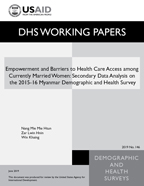- PUBLICATIONS
- JOURNAL ARTICLES
- ACCESS PUBLICATIONS
Publications Summary
- Document Type
- Working Papers
- Publication Topic(s)
- Adult Health Issues, Gender
- Country(s)
- Myanmar
- Survey
- Myanmar DHS, 2015-16
- Language
- English
- Recommended Citation
- Htun, Nang Mie Mie, Zar Lwin Hnin, and Win Khaing. 2019. Empowerment and Barriers to Health Care Access among Currently Married Women: Secondary Data Analysis of the 2015-16 Myanmar Demographic and Health Survey. DHS Working Paper No. 146. Rockville, Maryland, USA: ICF.
- Download Citation
- RIS format / Text format / Endnote format
- Publication Date
- June 2019
- Publication ID
- WP146
Download
 Empowerment and Barriers to Health Care Access among Currently Married Women: Secondary Data Analysis of the 2015-16 Myanmar Demographic and Health Survey (PDF, 746K)
Empowerment and Barriers to Health Care Access among Currently Married Women: Secondary Data Analysis of the 2015-16 Myanmar Demographic and Health Survey (PDF, 746K)
